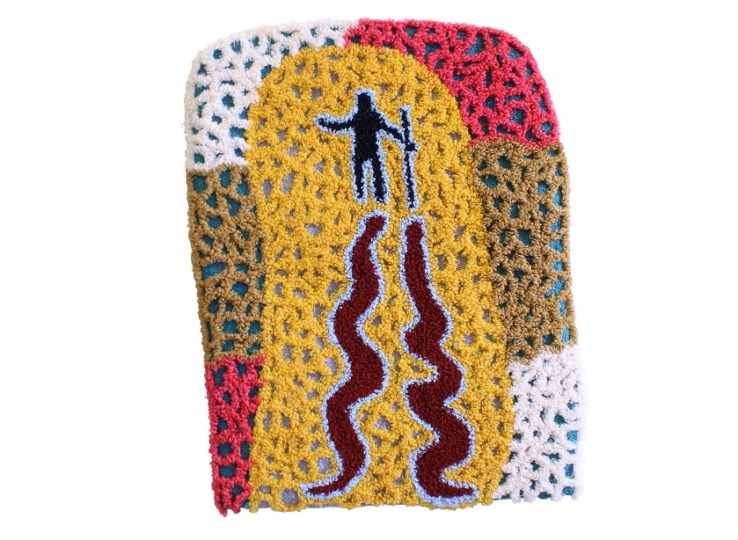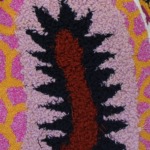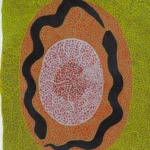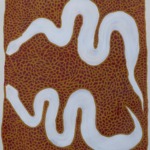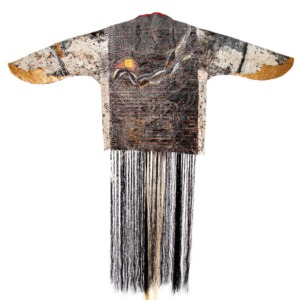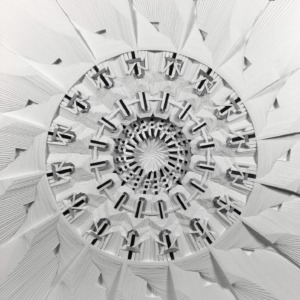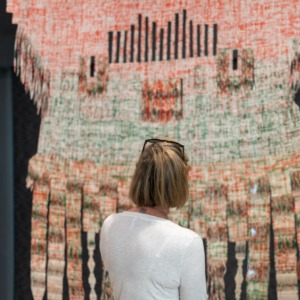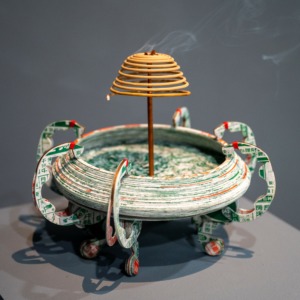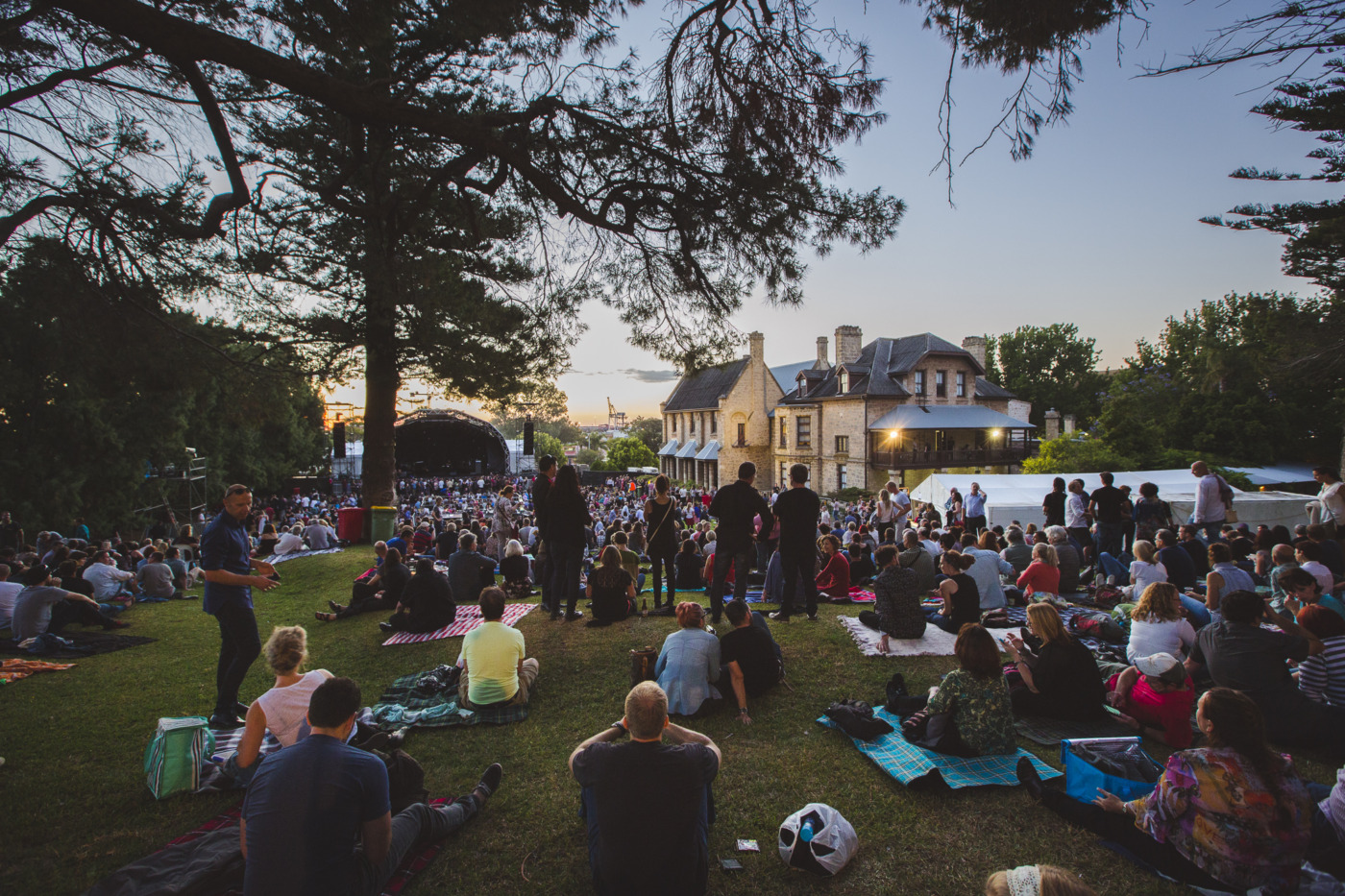Opening on Friday 12 August, Jila Kujarra | Two Snakes Dreaming is a dynamic cross-cultural collaboration between Warnman artist Desmond Taylor and Boorloo-based textiles practitioner Mariaan Pugh.
Taylor and Pugh have worked together to transform Taylor’s Niminjarra paintings, usually seen on canvas or paper, into ten large-scale textile works, reanimating the important Niminjarra Jukurrpa (Dreaming).
The exhibition is the realisation of a long-held vision of Taylor’s, a prolific painter who works with Martumili Artists. It continues the practice of cultural and creative exchange driven by the arts centre in recent years, with the intent of sharing Martu art, language, culture and stories with new national and international audiences.
“The idea for the rugs came many years ago when I was looking at different ways of trying to find my own style of artwork and create a pathway for my work,” says Taylor.
“I always wanted to concentrate on one Jukurrpa, one storyline of a Dreaming path that our people are descendants of. Sharing this story is about giving people the opportunity to learn about the first culture that’s been in Australia before settlement.”
- Mariaan Pugh, Niminjarra (nyurnma), 2021, assorted yarn, monks cloth
- Mariaan Pugh, Niminjarra (home camp), 2021, assorted yarn, monks cloth
- Desmond Taylor, Niminjarra, 2019, gouache on paper, 50 x 65cm
- Desmond Taylor, Niminjarra (resting), 2020, gouache on paper, 51 x 66cm,
Desmond’s exquisitely detailed Niminjarra paintings follow the Jukurrpa (Dreaming story) of two brothers, who transform into snakes so they can return home to Ngayartakujarra (Lake Dora), a sacred part of Martu Country.
Made by hand with painstaking precision, Mariaan Pugh has translated Taylor’s paintings into large scale tufted rugs. Displayed side by side in the exhibition, audiences will be wowed by their extraordinary likeness and the incredible craftsmanship of each distinct medium.
“It’s been a joy and a privilege to work with Desmond to expand his practice into an entirely new medium,” says textile artist, fashion
designer and educator Mariaan Pugh.
“Given the cultural significance of his works, I’ve been careful to stay true to his paintings as much as the medium allows, although we’ve had to make a few tweaks here and there.”
“I really love the practice of tufting, it’s a highly tactile medium and it’s so satisfying to see the design come to life, thread by thread. It can take upwards of a week just to complete one rug.”
According to FAC Curator Visual Arts Glenn Iseger-Pilkington, “This exhibition represents the ambition of a Martu artist to tell his Dreaming stories in a way that increases the accessibility and reach of his paintings beyond a canvas.”
“It also demonstrates the importance of fostering cross-cultural collaborations in ways that are ethical and culturally sensitive, that show respect for culture while opening up new income streams and possibilities for First Nations artists.”
Jila Kujarra: Two Snakes Dreaming opens 6:30pm, Friday 12 August alongside A Gentle Misinterpretation: Australian Artists and Chinoiserie and Tania Ferrier: Pop Porn. The exhibitions are then open 10am – 5pm daily until Sunday 23 October.
A series of public programs will run in conjunction with the exhibition, including Artist Talk | Jila Kujarra: Two Snakes Dreaming + Tania Ferrier: Pop Porn on Saturday 13 August. Please visit fac.org.au for more information.
For interviews or further information please contact Media Officer Rosamund Brennan via rosamundb@fremantle.wa.gov.au or +61 (8) 9432 9565
Hero image: Mariaan Pugh & Desmond Taylor, Niminjarra, 2022, assorted yarn, monks cloth. © Courtesy the artists. A collaborative project between the artists, Fremantle Arts Centre and Martumili Artists, 2020-22.
Chinoiserie – the Western appropriation of Asian aesthetics – rose to prominence in eighteenth century at a time when the British Empire was exerting extraordinary dominance over the global market; effectively undercutting the original artisans and commodifying meaningful cultural artefacts.
Opening at Fremantle Arts Centre on 12 August, A Gentle Misinterpretation: Australian Artists and Chinoiserie is a contemporary exploration of this problematic practice, presenting thirteen artists whose works reflect on notions of cultural thievery, colonisation, exoticisation, and excess.
Conceived and curated by Andrew Nicholls, the exhibition is the culmination of a seven-year research and development project, including residencies at Brighton’s Royal Pavilion, (the seaside pleasure palace of George IV and the world’s most spectacular remaining example of Chinoiserie architecture), and The Pottery Workshop in Jingdezhen, China.

Tanija and Graham Carr, Chinoiserie Group (detail), 2017-2022, leather, stained finish, 170 x 60 x 70cm. Photography by Victor France. Image courtesy the artists
Including several new commissions produced during the residencies alongside existing works, A Gentle Misinterpretation features Abdul Abdullah, Casey Ayres, Nathan Beard, Sandra Black, Tanija and Graham Carr, David Charles Collins, Theo Costantino, Susan Flavell, Tarryn Gill, Pilar Mata Dupont, Cherish Marrington and Andrew Nicholls. The exhibition also includes works produced in collaboration with artists from Jingdezhen, China, residents of Brighton, UK and Perth-based classical music collective HIP Company.
Named after the comments of Robert Copeland, an ancestor of one of the UK’s most iconic China dynasties, who described Chinoiserie as ‘a gentle misinterpretation’ of Chinese culture, the exhibition is an opulent, sensual and comedic exploration of one of Western culture’s most fascinating aesthetic curiosities.
“A Gentle Misinterpretation is a real passion project for me,” says the exhibition’s curator and exhibiting artist Andrew Nicholls. “In my practice, I like to explore antiquated and historical art forms through a contemporary lens, highlighting some of the broader historical context that informs them.”
Varying in medium, scale and approach, the exhibiting artists engage with Chinoiserie from a multitude of angles. Some have referenced the opulence and excess of the Chinoiserie genre and George IV’s notorious decadence, others have interpreted the broader themes of colonialism and cultural thievery, or the nuanced relationships to their own cultural heritage and ties to the region.

Abdul Abdullah, Dispossessed (detail), 2015, digital video 2 minutes 13 seconds (with credits and soundtrack)
Thai-Australian artist Nathan Beard is exhibiting a series of porcelain vases cast by Jingdezhen artisans and featuring hand-painting by cobalt master Yu Xuan. These collaborative works reinterpret scenes from the Kachin region of Myanmar (a country bordering China and Thailand) in the style of traditional Chinese porcelain art, reflecting multiple layers of cross-cultural and colonial scrutiny.
Shot in the Royal Pavilion’s Music Room, Abdul Abdullah’s lavish video work Dispossession features Abdullah and Brighton-based actress Sidonie Bond, performing a scene from Shakespeare’s The Tempest. Abdullah plays the slave Caliban, a character he has portrayed in numerous self-portraits in recent years, while Bond is Miranda, his oppressor – offering a new lens on this storied power dynamic within a space loaded with imperialist history.
Interrogating George IV’s excessive lifestyle, Tarryn Gill’s Surely This is Death is an installation based upon satirical cartoons mocking George’s penchant for overeating and his taste for the exotic, while Pilar Mata Dupont’s sound installation, which can be encountered throughout the exhibition, draws on correspondence, financial and medical documentation relating to George’s lifestyle, spending and health.
Andrew Nicholls is presenting a series of porcelain objects including A Gentle Misinterpretation, a collection of recycled and repurposed vintage dinnerware. Adorned with Blue Willow – the most enduring example of Chinoiserie, designed in the UK – the works demonstrate the pervasive nature of Britain’s China production, which was so effective that Asian ceramicists were forced to copy the design.
In a nod to George IV’s substantial legacy of arts patronage, the various residency outcomes are complemented by commissioned objects from some of Western Australia’s senior-most craft makers, including Sandra Black and Susan Flavell, and Tanija and Graham Carr, whose works draw inspiration from Asian aesthetics.
According to Glenn Iseger-Pilkington, Curator Visual Arts at Fremantle Arts Centre, “Hidden behind Chinoiserie’s aesthetic charm is a much darker narrative of dispossession and cultural thievery, practices of erasure on which empires are built, and histories are rendered.”
“A generous and insightful exhibition which explores aesthetic legacies, A Gentle Misinterpretation prompts us to question the euro-centric gaze and to remain curious about the provenance of cultural artefacts, symbols and visual languages. The exhibition is a timely reminder that the cultural work we do today leaves a legacy and a narrative for future minds to explore and critique, and to truth-tell around.”
A Gentle Misinterpretation: Australian Artists and Chinoiserie opens 6:30pm Friday 12 August alongside Jila Kujarra: Two Snakes Dreaming and Tania Ferrier: Pop Porn. The exhibitions will be open daily until Sunday 23 October.
A series of public programs will run in conjunction with the exhibition, including Disclosure: Beg Borrow and Steal with Andrew Nicholls on Tuesday 30 August.
For interviews or further information please contact Media Officer Rosamund Brennan via rosamundb@fremantle.wa.gov.au or +61 (8) 9432 9565
Hero image: Andrew Nicholls and Jingdezhen artisans, Untitled (Cobalt Skull #1), hand-painted cobalt on porcelain, dimensions variable. Cobalt painting by Yu Xuan, 2016. Photography by Bewley Shaylor.
Have you been curious to learn what’s coming up at FAC over the next few months?
Wonder no more because our Jul–Sep 2022 Program has just been released!
This is your comprehensive guide to all our upcoming exhibitions, insightful talks, late night events, gigs, art courses, studio artists and more.
Keen to attend? Find out about our:
Subscribe to our newsletter to receive event news in your inbox
Top image: Andrew Nicholls and Jingdezhen artisans, Untitled (Cobalt Skull #1), hand-painted cobalt on porcelain, dimensions variable. Cobalt painting by Yu Xuan, 2016. Photography by Bewley Shaylor
“It is time to see stained glass as art of the future, not only of the past. It does not belong only in the realm of the ecclesiastical, but in the clamorous space of daily life, philosophical preoccupations and the convergence of nature and the industrial.”
Residing in Perth on Whadjuk Nyoongar Boodjar, Hannah Gregory is an Australian leaded stained-glass artist who is currently in residence at Fremantle Arts Centre. After dedicating years to honing her craft working in glass studios across Australia on larger public works and lengthy restorations, Hannah is now solely focusing on her own practice, commissions and autonomous works.
Returning to her hometown of Perth after attending residencies in Austria and Wales, Hannah is experimenting with sandblasting, painting, leading, plating and kiln forming. Her goal during her residency is to make pieces that provoke thought as light provokes life using natural inclusions and inspiration from the Western Australian coastal landscape.

Hannah Gregory in her FAC Studio
You’ve been working as a glass artist for 6 years. What is it about working with this medium that appeals to you?
There’s a couple of reasons why I’m drawn to glass. I think there’s a real egoless-ness to it which is embedded in the history of glass art. For example, historically with stained glass in ecclesiastical churches, you weren’t making the windows for you, you were making them to serve a higher purpose. Even though I’m not religious, I like the idea that it’s not all about the artist per se; it’s about something bigger than you.
And I love that you are just facilitating the art a lot of the time because the light does all of it. I love it because the potential is limitless. It’s kind of been stereotyped with people thinking stained glass is only for churches or old-fashioned houses, but it’s so much more interesting than that.
Tell us about your practice. What kind of work are doing at the moment?
My practice is largely lead-based, so stained glass. I paint on glass which is quite specialised and at the time I started it was impossible to learn in Australia, so I had to go overseas. I also work with the sandblaster and enamels – all different sorts of things! All my pieces require kiln firing, my kiln is my best friend.
My practice is mostly commission-based but at the moment, on this residency, it’s more experimental and later in the year I’m going to the US for a fellowship which is more painting-based. It’s a mixture of large architectural commissions for commercial spaces or private homes, painting and more experimental work.
I also do little drops on Instagram of tarot cards and different things which are more ephemeral for people who don’t necessarily own their home or people who move around. I really like the idea of these smaller pieces and they are quite popular. I think stained glass is having a revival.
Tell me about the experimental work you’ve been doing while on this residency?
Like everyone in Australia I spend a lot of time on the coast. I’ve been experimenting with using seaweed which I’m finding quite interesting. So largely I’m trying to fuse these natural elements between glass and create patterns with the natural materials. I also love experimenting with plating, which is where you layer sections of glass. I’ve been going through a process of compressing seaweed so it dries and becomes like a pressed flower. I’ve been really enjoying that. There’s something that I find so interesting about seeing something so familiar to us in a foreign way like a piece of seaweed between glasses, it looks quite isolated. I not 100% sure where this work is going, but I guess that’s the point of the residency, to be able to explore.
You are part of a league of artists who are modernising the medium of stained-glass art. How have attitudes towards glass art shifted? Do you feel there is a greater appetite for the medium both commercially and in contemporary art?
I would say that there have been multiple movements in the past which perhaps have been accelerated by social media, but the one we’re seeing now I think is happening largely because people are starting to value handmade, bespoke products. People are becoming more disenfranchised with fast anything – whether that be fast fashion or fast furniture. It seems to me people are yearning for things that are unique and that relate to them. That has created a market for a lot more stained glass to be made and made in a different way. You’ll see a lot of décor-style stained-glass on Instagram, which is usually the copper foil method, but then you’ll see a lot of people that are approaching it in an architectural way that’s a bit different. I kind of do both. I think in the end, it does come down to the idea that everyone wants to invest in something that’s unique. People are starting to be a bit more thoughtful with where they put their money, and I think that means there’s more support for artists than ever before.
Follow Hannah on Instagram or visit her website to find out more about her work

Hannah Gregory, Sea Sponge painted with sea sponge, 2022. Image courtesy the artist
An ambitious new theatre company dedicated to “making invisible stories visible”, Encounter was founded in 2021 by theatre-maker, writer and director Jay Emmanuel.
Currently in-residence at Fremantle Arts Centre, Encounter specialises in storytelling that embraces diversity, creating space for people of migrant, refugee and queer communities to speak their truth while revealing universal experiences of identity, community, and the search for belonging.
It’s an ethos that is entirely congruent with Jay’s artistic oeuvre. Migrating to Australia in 2009, Jay has forged a career that integrates his personal experiences, including his upbringing in India and classical training in Kathakali dance, while also seeking to achieve greater representation of marginalized voices on stage from the spectrum of communities that constitute contemporary Australia.
His critically acclaimed 2021 play Children of the Sea is archetypal of this approach. The culmination of two years of research and significant community engagement including more than 60 interviews, the play weaves together real stories of four maritime survivors who came to Australia by boat.
With a number of new projects on the horizon, we sat down with Jay in the studio at FAC to learn more about his vision for Encounter.
Prior to founding Encounter, you were primarily working as an independent theatre-maker. What sparked the creation of this new collaboration, and what gap did it seek to fill in the sector?
Encounter came from the need to tell stories authentically, to create change around the stories we see on our main stages. I grew up not having role models or stories where I could see people like myself on stage. With the creation of Encounter, I wanted to make sure those stories exist for the next generation. There are so many stories here in Perth, and indeed in Australia, but we often just don’t see them, or they are isolated to certain parts of the community. We want to be a place where those diverse narratives find expression, to be a sanctuary for solidarity. We see ourselves as shapers of the nation’s cultural future, that’s our duty.

Jay Emmanuel in the Encounter studio space at Fremantle Arts Centre
Your methodology is rather unique in that you perform significant research and consultation with marginalized communities, such as your work with refugee communities for Children of the Sea. Can you tell me a bit more about this process?
The work Children of the Sea was not only made with the community, it was about the community and the community was also on stage. We didn’t have any blueprints for that process, there aren’t many theatre companies that are creating this kind of work. The process is very heavily based in community arts and cultural development (CACD) processes. It involves rigorous consultation, research and also building trust with community groups over many years.
The stories we present on stage are essentially derived from people in the community; where community becomes active creators in the process and our artistic decisions are influenced by those conversations. For Children of the Sea, we had people from the refugee community on stage, telling their stories. We aim to build this kind of porous relationship between Encounter and the community.
Encounter’s vision is to create a platform for diverse storytelling and foster a diverse theatrical workforce. What strategies are you employing to make this happen?
One of the biggest challenges of making the kind of work we make is the shortage of actors, performance devisers, musicians, composers and designers from ethnically diverse backgrounds. The workforce is incredibly limited. Even searching nationally and (sometimes) having the resources to bring cast and creatives from around the country, it is still limited. It speaks to a greater problem in the system.
Our approach to capacity development sprung from Children of the Sea, where we did a lot of skills development with young people. From that, there came this idea of doing a youth ensemble where the cast of Children of the Sea are paired with five more young people who are going through a program where they get upskilled in theatre making practitioners from WA and around the world. This time, we have Roslyn Oades who is a verbatim artist from Melbourne and Kelli McCluskey from PVI Collective to facilitate practice sharing, and also other practitioners who will offer their expertise. Coming soon, we have an emerging artist program to foster the skills of practitioners who already have some experience.

Encounter creative development team – back row L-R: Jay Emmanuel, Sukhi Shetty Krishnan, Emily Kingsley; front row L-R: Sunili Govinnage, Asha Kiani, Tyrone Earl Lraé Robinson, Manjula Radha Krishnan. Photo credit: Christophe Canato.
Your productions often meld together diverse cultural practices and traditions, such as Kathakali dance, which are not often seen in mainstream theatre. Why is this approach so important to you?
Nurturing a diverse workforce is our number one priority, but our second priority is diversifying the stories we see on stage and how these stories are told. Our mainstream audiences are accustomed to seeing realism, naturalism, Chekov and Shakespeare, but in the Asia Pacific region alone, there are writers and artists and forms of storytelling and puppetry that have been around for thousands of years. But why don’t we see them on stage? Encounter is focusing on reviving these practices and remembering that they exist, and creating that link where we can bring them into the popular culture.
For example, training to be a Kathakali dancer takes about 12 years, but here in Australia it’s not really recognized as a valid practice in mainstream training, it is just placed in a box of ‘community arts’. So what we’re trying to do is push for other forms and theories of storytelling to be given equal value. And that’s why I guess I always go to the community for inspiration, because I feel that’s where a lot of the storytelling with authentic power and prowess exists, rather than just feeding into the status quo.
What kinds of cultural practices have you been integrating into your performances?
For example, in the last three weeks we were in the development of a new project called Sunset (working title). The ethos of creation is driven by curiosity and experimentation. In this development we used Kalari which is an ancient form of Indian martial arts, about 3000 years old. We use it for actor training, because our work tends to be more physical and visual. We also have been experimenting with vogue. It’s the language of the queer community, and it’s how we have come to claim our history and express our history, but it’s rarely seen in the theatre. So we do go from very ancient practices like Kalari to more contemporary practices like vogueing. We’ve also worked with Bharatanatyam which is a South Asian form of classical dance and Indonesian shadow puppets. We explore a diverse cultural terrain in our work. It requires us to translate between cultures, and to find accessible ways of communicating ancient myths, practices and rituals for a contemporary audience.

Encounter ensemble members Sukhi Shetty Krishnan and Manjula Radha Krishnan during a creative development workshop.Photo credit: Christophe Canato.
Encounter was launched at Fremantle Arts Centre in late 2021, and you’ve had a studio space here for almost six months. How are you finding it so far? What kind of activities has the space enabled?
This studio has been really instrumental as a place to gather. We are able to use it for script developments, script workshops and choreographic work, gatherings, donor events etc. Also, our associate artists – our core performers who we bring across all developments – can come and use the space as they like.
We’ve also used the Pavlich room for a couple of creative developments and workshops on devising, puppetry and vogueing. And of course, we had the launch of Encounter Theatre there some months ago. It’s been really great to use as a space to gather our supporters, a place where we can invite people to hear about our work.
Being situated at FAC also helps a lot because people recognize this place, they trust it. It’s an iconic Fremantle hub. Being surrounded by artwork in the galleries and working alongside studio artists from different disciplines is quite inspiring as well, on a conscious and sub-conscious level. I’ve had great conversations with other artists in the grounds. It’s really become the home for our company here.
Support the work of Encounter by contributing to their Australian Cultural Fund donor drive.
Six Western Australian artists have been selected as the inaugural participants in Fremantle Arts Centre’s Groundwork program, a unique new career-bolstering initiative which supports artists to develop their career pathways and realise bold new work.
The six selected artists – Jack Ball, Rachael Dease, Yabini Kickett, Adelina Larsson, Bennett Miller and Taonga Sendama – will enjoy access to a Fremantle Arts Centre studio space and receive a weekly wage for three months while participating in the intensive, artist-led creative incubator.
This model allows each participant to receive meaningful, targeted support in areas they feel it will most benefit their practice and development. Selected from almost 200 applicants, Fremantle Arts Centre Director Anna Reece said the overwhelming response to Groundwork demonstrated the significant gap in the WA sector the program seeks to address.
“We received just under 200 applications to Groundwork from the most extraordinary and diverse group of artists. Every application voiced such a critical need for time, space and financial support for artists. It is important to acknowledge this and continue to advocate for greater resources and opportunities for artists and we are grateful to the Australia Council for the Arts for enabling this initiative to take place,” Fremantle Arts Centre Director Anna Reece commented.
“It was an incredible privilege for the panel to view each and every application and we found it enormously difficult to make our final decision. The six successful applicants articulated clearly what the qualities of the program on offer would contribute to their practice and the outcome it would enable. They demonstrated a generosity and flexibility, an openness and desire to working with others and a reflective practice. We look forward to welcoming this dynamic group of individuals to Walyalup and Fremantle Arts Centre.”
The artists will be in residence at Fremantle Arts Centre from September – November 2022.
Selected Artists
Jack Ball

Jack Ball lives in Boorloo/Perth and works with sculptural and collage processes to create photographic images, which are often bodily, performative, intimate and saturated with colour.
In 2021 they had a major solo exhibition at the Art Gallery of Western Australia titled Wind Chill that brought together images spanning 10 years of their practice, including works held in the State Art Collection. In 2021 they also had a solo exhibition with sweet pea gallery and had work featured in group exhibitions the pleasurable, the illegible, the multiple, the mundane (Artspace Sydney, curated by Talia Linz) and Love in Bright Landscapes (PICA, curated by Annika Kristensen).
For Groundwork, Jack will undertake archival research into trans magazine histories, which will inform new large-scale photographic and sculptural installation work. Through collage and abstraction, their work will explore themes of anonymity, pleasure, intimacy, and critically engage with narratives that shape trans lives.
Rachael Dease
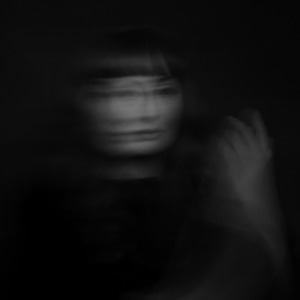
Rachael Dease’s artistic practice encompasses art music, dance and theatre scoring, installation and songwriting. Graduating from the Western Australian Academy of Performing Arts, she won the inaugural Martin Sims Award at Fringe World, the Melbourne Fringe Music Award and received critical acclaim at New York Fringe Festival for her contemporary song cycle City of Shadows.
Her composition and sound design for theatre include the Helpmann Award nominated It’s Dark Outside (The Last Great Hunt), City of Gold (Sydney Theatre Company /BSSTC), The Bleeding Tree (Blue Room Theatre) and Mary Stuart (Perth Festival). Installation includes Vespers (Fremantle Biennale), Black Mass (PICA) Winter Feast 2018-2022 (Dark Mofo), Museum of Water (Perth Festival), and Like Embracing Ice (Fremantle Arts Centre).
In 2020 Dease was Prelude Composer in Residence at Gallop House, Western Australia where she wrote her first solo album Hymns for End Times which was performed with the West Australian Symphony Orchestra in February 2021 for Perth Festival. Dease has recently returned from Sweden, fulfilling a two-year collaboration with Maxine Doyle and Es Devlin on Here Not Here for Gothenburg Opera Dance Company.
For Groundwork, Rachael will incubate a new large-scale sound work, dedicating time to creative and technical research.
Yabini Kickett

Yabini Kickett (Esther McDowell) is a descendant of the Kickett and Hayden families of the Bibulmun/Noongar Nation. Having grown up with an artist and poet mother, as well as a photographer and land conservationist father, her practice is heavily rooted in language,
endemic plants, family, totemic relations and found objects from country.
In the past four years while working with Noongar Youth part time, Yabini has focused on mediums including textiles, eco dye, found object as well as film and digital photography. Her work comes back to place and orienting herself within disturbed ground.
In 2021 her work I want to go home but they killed her (2020) and Kalaak dress (2019) were acquired by the Art Gallery of Western Australia as part of their COVID-19 Stimulus program. Since then, she’s been exploring curation and portraiture, predominantly working in oil and chalk pastels.
For Groundwork, Yabini will explore portraiture and more abstract illustration on a much larger scale.
Adelina Larsson

Adelina is an award-winning Swedish/Mexican choreographer, curator, producer, and educator. She works and lives on the land of the Wadandi people – the traditional custodians of Wooditjup/Margaret River, WA.
She trained at Stockholm University of the Arts, DOCH and CODARTS, Rotterdam. Since moving to Australia in 2007 she has worked in remote and regional communities and choreographed for performing arts companies presenting at Melbourne International Arts Festival, Federation Square, The State Theatre Centre of WA, Australian Institute of Sport, The Canberra Theatre Centre, PICA, The Lock Up, and Fremantle Arts Centre.
During Groundwork, Adelina will develop the installation and audience-centred part of her project Min folkdans / ihtotia mahcehua (My Folk dance). The work explores themes of identity, politics, and nostalgia through the histories of Adelina’s dual cultural heritage.
Bennett Miller

Bennett works across sculpture, installation, video and performance. He has a background producing works for the gallery, but increasingly also develops ‘living sculptures’ for festivals and outdoor contexts.
Since 2010 Miller’s Dachshund UN has been presented in Melbourne, Sydney, Perth, Birmingham (UK), Toronto and Montreal (CAN). In 2012 Miller was included in New12 at ACCA, Melbourne and was a resident at Australia Council’s Greene St Studio in New York. From 2013-2016 Miller presented four consecutive iterations of his fake Amish community at Splendour in the Grass Festival in NSW.
In 2019 Miller presented Behavioural Ecologies (Red) as part of the Fremantle Biennale and he is currently undertaking a residency in Mt Barker for the Spaced 4: Rural Utopias program. For Groundwork, Bennett will develop a new series of performances and associated sculptures within FAC’s grounds.
Taonga Sendama

Taonga is a poet, multimedia storyteller and workshop coordinator. Currently her primary focus is community, specifically creating space for other BIPOC artists to share their work. As a Black femme, her work is determinedly and fiercely vulnerable, focusing
predominantly on grief, nostalgia, rest and other small revolutions of the heart.
After her debut at the Western Australian Youth Slam in 2017, she has since featured at the Perth Poetry Festival, National Young Writers’ Festival, and facilitated workshops for Curtin University. In 2021 she was granted the Tina Kane Emerging Writer Award during the Mildura Writers Festival and in 2022 she participated in the Centre for Stories Hot Desk Fellowship.
For Groundwork, Taonga will explore her multimedia project June Rain and allow herself to explore new avenues as an emerging artist. The process will be documented through film photography, poetry, and audio-visual notes.
For interviews or further information please contact Media Officer Rosamund Brennan via rosamundb@fremantle.wa.gov.au or +61 (8) 9432 9565
Photography by Jessica Wyld
A recent Artist-In-Residence at Fremantle Arts Centre, Jacky Cheng is an artist and an art educator based in Broome, Western Australia. A finalist in the 2022 Blake Prize and the John Stringer Prize, her work is an exploration of identity through cultural activities and memories of home; country and relationships. We recently caught up with Jacky Cheng to find out more about her practice and the body of work that caught the attention of one of Australia’s longest-standing and most prestigious prizes.
Jacky Cheng
Website: https://jackycheng.com.au/
Instagram: @jackychengart
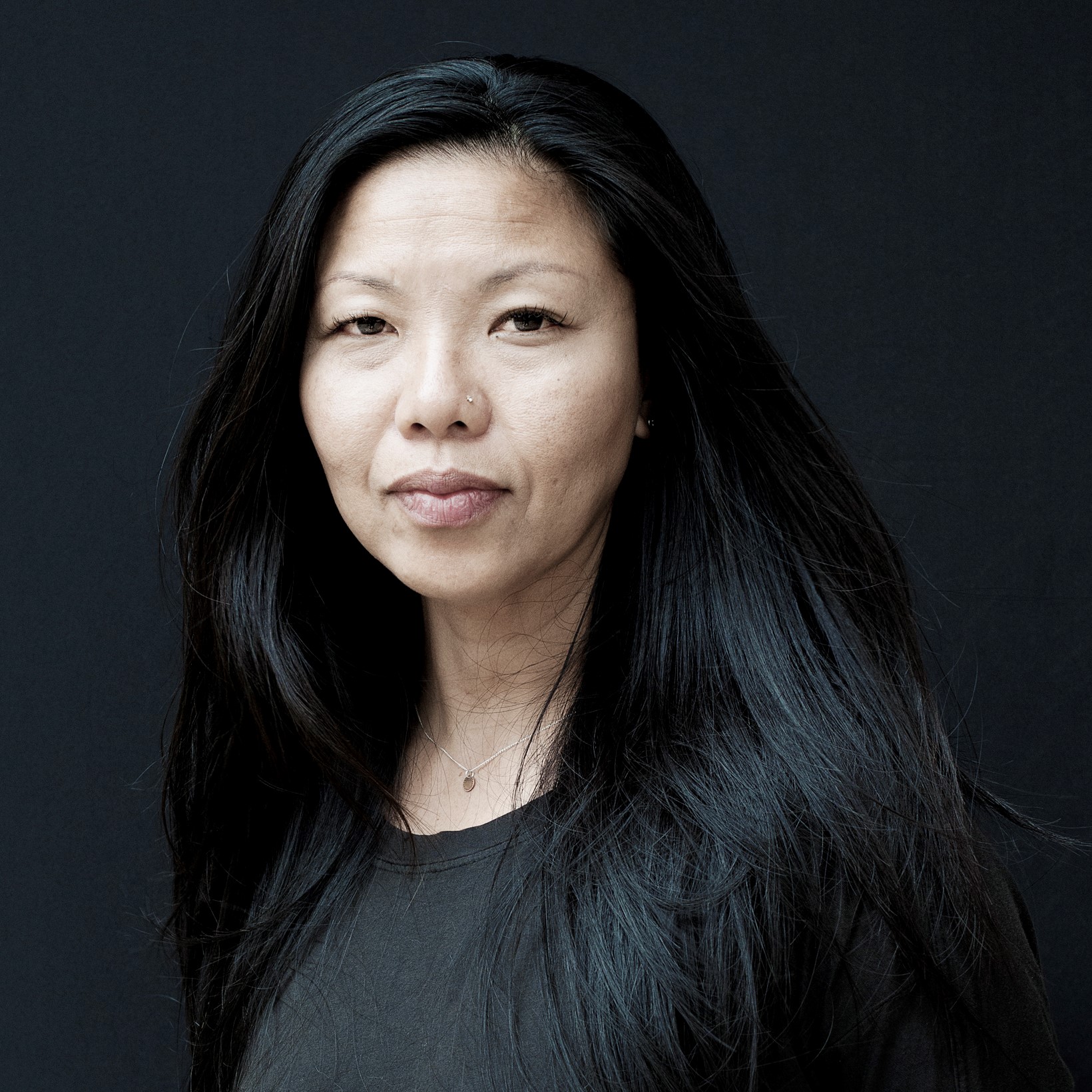
Portrait of artist Jacky Cheng. Photography by Brett Canet-Gibson
Jacky, you’ve just finished up a residency at FAC. What have you been working on?
I’ve been on a methodology journey. I am currently fixated on making paper threads (kami-ito) from the kozo papers (kigami) I made during a residency in Awagami Factory in Japan back in 2019. Both the papermaking and paper thread making is extremely laborious but at the same time incredibly powerful to have this knowledge. My approach to the residency thus far is about researching, exploring and testing the methodology with the papers I made and various other papers either found or commercially manufactured and at the same time, interrogating my temperament. Due to its lengthy process, it requires the patience of a saint, and there is that constant conversation in my head about the future impact and sad loss of not having these techniques or skill shown or talked about in our contemporary society. It is an impending fear that our future generation may only continue to read this in the past tense rather than a celebrated technique in our contemporary art practice. So, I’ve dedicated my time at FAC to the a strict diet of discipline and a ritual of consistency and rigour – turning up everyday – cut, roll, spin . I am such a studio creature. Being in a dedicated space with uninterrupted time feeds clarity. I look forward to work everyday.
This is not your first time as a resident at FAC. What keeps you coming back?
One of the best aspect of residencies are the non-prescriptive expectations from practitioners. FAC is unique and incredibly diverse in the workforce – everyone is either a practicing artist or works in a creative industry in one way or another. Everyone is super friendly, incredibly helpful and supportive, skillful, knowledgeable, communicative and champions each other. There are always people on the ground ready to assist with your queries. It is the people that makes the place great. I recently read somewhere where FAC is termed as the creative campus. I think it is absolutely apropos to Walyalup and to the surrounding artistic community.

Jacky Cheng working in her studio at FAC
I understand wanted to be an architect in Malaysia until a life-changing holiday in the Kimberley led you to the arts. Can you tell us a bit about that?
I grew up in the city (M’sia) and then moved to another city (Sydney) for my tertiary education. I was sold the impression to be successful is to be a professional in the city. The ease of navigating myself in a cityscape is convenient and familiar. My move to the Kimberley stemmed from my first encounter with a Broome local in a local cafe where she told me about her background and multiracial identity. It dawned on me that I knew nothing about Australia and First Nations people. My first trip to a remote indigenous community was a memorable one. I was sent out there to teach as a TAFE arts lecturer. Long story short, it took me a while to realise that story-telling is a way of making sense of someone or where they come from. They loved listening to my experiences as a Malaysian Chinese immigrant in the Kimberley and I love listening and learning about their ancestral connections to land, sea and sky. There is a plethora of similarities in our exchange which includes the non-verbal deliveries, such as the nuances of sitting together quietly. There is that beautiful calm in story-telling until one of us starts cackling and infects the rest of the group. It felt like home to me.
Your work often explores the duality of being a Malaysian expatriate in Australia, while also being ensconced in the First Nations culture and spirituality of Broome, where you live. What is it about this you find so interesting?
In Malaysia (and possibly in the neighbouring country, Singapore), the term Banana Girl is very common and often associated with people of Chinese descendent who aren’t able to read, write or speak Chinese. My mum refers me a Banana Girl. When I was younger, following the Western culture was pretty cool and current because that was the only ‘outside’ influence we were exposed to via television. I attended public school where Bahasa Malaysia was the predominant written and spoken language in our school work except English lessons. Outside of school and or at home, I would speak in a mix of Cantonese, Mandarin, English or Bahasa and sometimes both my grandmother’s dialects Hainanese and Teochew. But I am neither fluent nor excellent in any of my ancestral native languages. My first public shaming experience was when I was travelling in Hong Kong, proudly showing off my spoken Cantonese to my travel buddies as if I’ve got their back only to realise that I was shamed by a local resident of my ‘defect’ when I fail to read his writing when I’ve just spoken to him in Chinese. It is a literal sense of feeling in-between and being Chinese but not Chinese enough. But the more visceral way of experiencing this is the fact I felt the invalidity of my sense of belonging.
- Jacky Cheng, Honour and Love
- Jacky Cheng, Xiang Lu III – Incense Cencer
When I arrived in Broome, I experienced the similar ‘multiplicity’ from the community. When I finally found some common stories or similarities of my native home identity in Broome, WA, I realised I never really left ‘home’ but more so embrace a slightly different narrative of ‘belonging’. My practice touched on personal experiences and at the same time taking the liberty to investigate the notion of ‘place and identity’ or what Broome or Kimberley means to me. Living and practicing in Broome is special. The motivation is different – it is respectful and sensitive story telling. Culture comes from place. Everyone has such a rich and diverse story with strong family connections. It continues to baffle me by how much more I do not know even after 16 years of living in the Kimberley. I channel that interdependence in my art practice. It embodies my practice with intent and with purpose.
Congratulations on being named a finalist in both the Blake Prize and the John Stringer Prize. How does it feel to be recognised in these prestigious awards?
One of my good friends told me about the Blake Prize after a brief conversation about the piece that I’ve been working on. I looked it up and saw the previous finalists names and thought to myself that I am no where at the level of these established artists with such rigour in their practice. Nevertheless, I thought I should give it a go. I’ve had plenty of rejection emails and unsuccessful selections in the past. It definitely helps define the work I do. I remember telling my partner and another friend the morning I received the congratulatory finalists news for the 67th Blake Prize. They congratulated me (but of course they had no idea what The Blake Prize is about…). I found myself skipping and smiling from ear to ear and crying at the same time. I am over the moon to be a finalist. That’s a win to me. As a regional artist, sometimes the distance hinders you from many great networking opportunities but of course with the accessibility of various online platform means that you are a tad closer… just a tad closer.
My Blake Prize submission is titled Yue Lao – The god of Matchmaking and Marriage, and it explores my late uncle’s marriage which was arranged by my Grandma, Ah Ma. Yue Lao is an old learned Chinese mythological cupid. He is believed to be immortal, and his focus is finding the perfect marriage matches for people. The work is made from sheets of recycled Chinese calendar papers that I religiously tear every day. In this in-between homeland – Australia, I struggle to clarify tales and myths with my elders. But there is a desire to understand why some practices still exist today but just in a different structure.
Jacky Cheng, Yue Lao – The god of Matchmaking and Marriage, 2022
The John Stringer Prize finalist announcement is another skip, ear to ear smile and cry moment too. I am in the process of making this piece and the work will be exhibited at the prestigious contemporary John Curtin Gallery in October this year. I am super chuffed with this opportunity and to be alongside my other finalist peers.
I understand your interest in paper and ‘slow art’ stems back to your relationship with your Grandmother. What kind of rituals did you practice together and how did these inform your practice?
The act of doing and making was already part of my upbringing. Folding thousands of joss papers in one sitting was not recognised as an artform at home but only as mandatory duty for girls/women. I most certainly was not allowed to pursue art as a career. So, I found the next best and most glamorous job in the dictionary and thought being an architect will somehow bring me closer to art. But of course, my intention was tested and the thought of me, a female, not carrying the family name after marriage is not worth the family’s investment. Long story short, I broke past that with my brother’s guidance in convincing my family that I am worth the investment in gaining a respectable qualification to aid my future endeavors. Then I rebelled. I jumped ship. I pondered this thought about my role as a female, home maker and how my name is less important than my brothers for a long time.
The thought process shifted when I was able to articulate the rituals we performed at home to my brother who has absolutely no clue. I found myself revisiting the process from the time I spent with my grandmother. There were ways of doing things that makes so much more sense now to me as an adult than when I was a child. The rituals, the making, the ephemeral beautiful folded paper works we prepare only to be burned away in the fire as an offering to the deities or ancestors. Bringing all these evocative sentiments into the studio, into my practice, enriched my role as a practitioner, a woman, homemaker, daughter, sister and more importantly a carrier of the ritualistic significance in my practice. My grandmother performed her role her entire life with very strict guidelines in her society. I will continue to perform my role in telling the stories and be the in-between of what ‘was’ and what ‘will I do’ to the next generation but maintaining the integrity of culture and its significance in the Taoist tradition. Paper is like my second skin. I’ve worked with paper since I was a child and there is so much more to learn about it in this lifetime. Perhaps that’s the narrative of ’slow’ I am referring to.
Jacky Cheng’s work is on display at the The 67th Blake Prize Exhibition – Casula Powerhouse Arts Centre till 22 May.
Fremantle Arts Centre’s April – June 2022 program has just been released.
Read the online version to catch up on all FAC’s upcoming exhibitions, evenings of discussion, special events, gigs, art courses and more.
Fremantle Arts Centre has been awarded a $100,000 grant from the Australia Council for the Arts to implement Groundwork, a new initiative which will bolster the careers of Western Australian artists, supporting them to develop new career pathways for the realisation of bold new work.
Groundwork will provide six practitioners with a studio space and a weekly wage while they participate in an intensive, three-month creative incubator designed to support the creation of new work, develop their arts business acumen and engage in critical response and review.
Facilitated by FAC and its partner organisations, Groundwork will provide access to a range of meaningful resources and support, including structured professional development, networking with senior artists and arts managers, access to studio space, support with installation, production and presentation of works as well as cross-industry collaboration.
According to Fremantle Arts Centre Director Anna Reece, “Groundwork has been developed in response to the significant gap within the Western Australian arts sector for structured outcome-based capacity building for artists across disciplines.”
“As a creative campus committed to fostering a community of innovation and collaboration, Groundwork harnesses FAC’s existing activities to offer a cohesive and accessible program that maximises opportunity and impact – empowering practitioners and providing them, with the resources they require to embrace risk and engage in rigor in their practice.”
“We are truly grateful to the Australia Council for the Arts for this grant enabling us to appropriately and strategically support our cultural ecology.”
While Groundwork is an outcome-based program, it is entirely artist-led, enabling each artist to self-determine the outcome they seek and address the most pressing needs of their practice.
Among the comprehensive range of support, resources and collaborations on offer, artists will have the chance to partake in a series of specially curated think tanks, featuring local and national provocateurs immersed in a conversation about culture, politics, technology and the environment through the lens of artistic practice. Recognising the importance of generating writing and scholarship around practice, FAC will also support one piece of long form writing in response to or around each artists’ practice and their work.
In keeping with FAC’s commitment to truth-telling and place-based narrative, Groundworks artists are provided with access to custodians of Nyoongar culture to inform their practice and ground their projects to the Country on which they are made, Whadjuk Nyoongar Boodjar.
Groundworks is open to all practicing emerging and midcareer artists working in a range of artistic disciplines with applications opening on Monday 4 April. The six selected artists will take part in the inaugural program from September to November 2022.
For full application details please see the Groundwork page.
For interviews or further information please contact Media Officer Rosamund Brennan via rosamundb@fremantle.wa.gov.au or 0434 936 355.
Photography by Jessica Wyld.
In consideration of the continued increase in community cases of COVID-19 and that cases are anticipated to peak at the end of March and into April we have made the following decisions regarding our Learning Classes for April – June 2022.
School Holiday Classes cancelled for April 2022
Unfortunately we will not be going ahead with our school holiday program for April 2022.
We look forward to welcoming all our creative kids back in the July holidays!
Term 2 Learning Classes
The commencement of Term 2 classes will be delayed.
We will be scheduling a 6 week program as opposed to the usual 9 week program and will continue with our one day or weekend classes as per usual.
REVISED KEY DATES
| Adults Term 2 | Classes Published Online | 11 Apr | |||
| Adults Term 2 | Member Enrolments Open | 13 Apr | |||
| Adults Term 2 | General Enrolments Open | 20 Apr | |||
| Adults Term 2 | Term 2 Dates | 23 May – 1 July |
| Kids Classes – July Holidays | Classes Published Online | 27 May | |||
| Kids Classes – July Holidays | Enrolments Open | 30 May | |||
| Kids Classes – July Holidays | Classes Underway | 2 Jul – 17 Jul |
We understand this will be disappointing news for our community. Please be assured that these decisions have been made after careful consideration and in respect to the safety of our community and our staff as our absolute priority.
